Lights Over Lapland has a full catalogue of exciting adventures in Abisko National Park, Sweden! Check out our daytime and evening activities and book your adventure! | | |
GEOMAGNETIC STORM IN PROGRESS: A minor G1-class geomagnetic storm is in progress on Nov. 30th as Earth enters a slow-moving but strongly magnetized stream of solar wind. This might be a co-rotating interaction region (CIR)--a shock-like boundary zone between slow and fast-moving solar wind. CIRs often do a good job sparking high latitude auroras. Aurora alerts: SMS Text.
ANDROMEDID METEOR OUTBURST: The Andromedids are back. Over the weekend astronomers reported an outburst of more than 100 faint meteors per hour. "[It was] the strongest outburst of Andromedid meteors ever detected by the Canadian Meteor Orbit Radar (CMOR)," says Peter Brown of the University of Western Ontario. This radar sky map shows a hot spot of meteor activity on Nov. 28th:
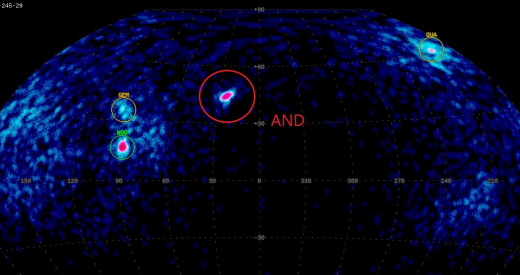
The shower's not over yet. "The current outburst is ongoing and it may be another few days or even a week before the activity ramps down," says Brown. "These meteors are too faint to see with the naked eye, but they are easy targets for our radar."
Andromedids are debris from Biela's Comet, known to historians as "the comet that split in two." 3D/Biela started to fall apart not long after it was discovered in 1772. It was a double comet when it swung by Earth in 1852 and, after that, was never seen again. In 1872 and 1885, thousands of meteors shot out of the constellation Andromeda as Earth passed through Biela's remains. Chinese records described "stars that fell like rain."
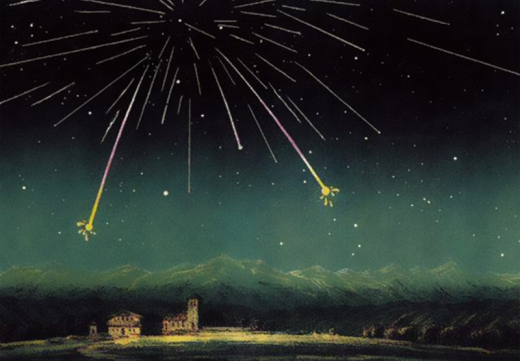
Above: Andromedids on the night of November 27, 1872, by Amédée Guillemin [ref]
Then the Andromedids vanished, too. The shower has been weak or absent entirely since the late 19th century. Only a surprise outburst in 2011 signaled that Biela's debris might still be lurking nearby. This week's activity is even more promising.
Bill Cooke of NASA's Meteoroid Environment Office (MEO) is one of several experts who have been modeling Biela's debris streams, hoping to forecast a return. "Our models generally do not do well in predicting the timing or intensity," he says. "However, this year our model got the timing roughly correct." This plot shows current radar data (red dots) vs. predicted debris stream crossings:
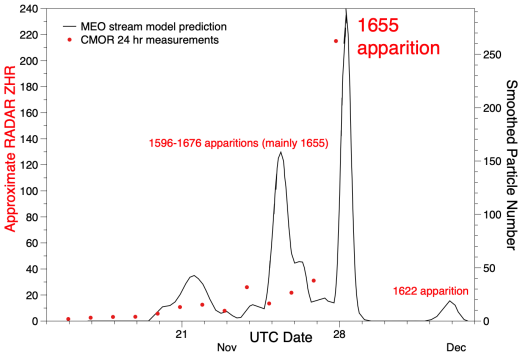
According to Cooke's model, the outburst on Nov. 28th was caused by a stream of dust laid down in 1655--interestingly before the comet fell apart. "We didn't think the 1655 crossing would produce much of anything," confesses Cooke. "So the outburst came as a bit of a surprise."
A team of astronomers led by Paul Wiegert (including Brown) had already predicted a strong naked-eye Andromedid outburst in December 2023. If they are right, the display two years from now could yield as many as 200 bright meteors an hour, surpassing even the Perseids and Geminids. The current outburst is providing new data for their stream models, and could help improve the predictions.
Stay tuned for updates as the shower continues.
Note: The Canadian Meteor Orbit Radar is operated through a cooperative agreement between Western University’s Meteor Physics Group and NASA’s Meteoroid Environment Office.
Realtime Space Weather Photo Gallery
Free: Spaceweather.com Newsletter
GIFTS FROM THE EDGE OF SPACE: Christmas is coming. Are you looking for a far-out gift? Check out the Earth to Sky Store. It's filled with unique items that have flown to the edge of space onboard cosmic ray research balloons.

Carried aloft by giant helium balloons, these unique gifts have flown above 99.7% of Earth's atmosphere, experiencing space-like blasts of cosmic rays, extreme cold, and a wild ride parachuting back to Earth after the balloon explodes. Even Amazon doesn't carry items this far out.
Don't forget to enter coupon code "BLACKPEARL" at checkout for a 15% Extended Black Friday discount.
Far Out Gifts: Earth to Sky Store
All sales support hands-on STEM education
Realtime Aurora Photo Gallery
Free: Spaceweather.com Newsletter
Every night, a network of
NASA all-sky cameras scans the skies above the United States for meteoritic fireballs. Automated software maintained by NASA's Meteoroid Environment Office calculates their orbits, velocity, penetration depth in Earth's atmosphere and many other characteristics. Daily results are presented here on Spaceweather.com.
On Nov 30, 2021, the network reported 34 fireballs.
(32 sporadics, 2 Nov. omega Orionids)
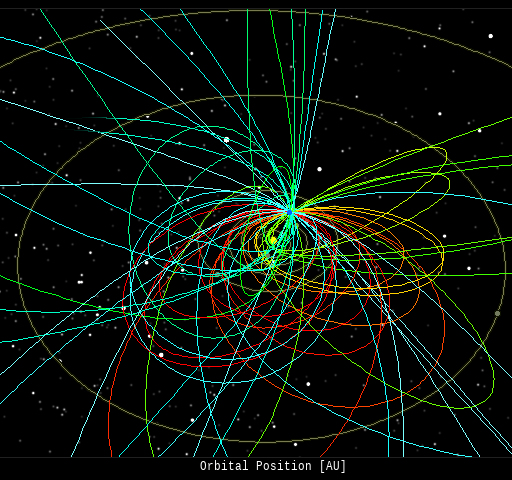
In this diagram of the inner solar system, all of the fireball orbits intersect at a single point--Earth. The orbits are color-coded by velocity, from slow (red) to fast (blue). [Larger image] [movies]
Potentially Hazardous Asteroids (
PHAs) are space rocks larger than approximately 100m that can come closer to Earth than 0.05 AU. None of the known PHAs is on a collision course with our planet, although astronomers are finding
new ones all the time.
On November 30, 2021 there were 2241 potentially hazardous asteroids.
 |
Recent & Upcoming Earth-asteroid encounters: | Asteroid | Date(UT) | Miss Distance | Velocity (km/s) | Diameter (m) |
| 2014 WF201 | 2021-Nov-25 | 14.1 LD | 5.5 | 27 |
| 2021 VR4 | 2021-Nov-25 | 2.1 LD | 7.7 | 19 |
| 2009 WB105 | 2021-Nov-25 | 15.1 LD | 18.9 | 71 |
| 2021 VQ27 | 2021-Nov-25 | 2.7 LD | 10.2 | 14 |
| 2021 VF11 | 2021-Nov-25 | 18.6 LD | 1.3 | 14 |
| 2019 BB5 | 2021-Nov-25 | 18.8 LD | 8.3 | 16 |
| 2021 WA1 | 2021-Nov-26 | 0.8 LD | 13.9 | 11 |
| 2021 VM | 2021-Nov-27 | 9.4 LD | 8.9 | 30 |
| 2021 WG3 | 2021-Nov-28 | 8.4 LD | 15.6 | 17 |
| 2021 WC1 | 2021-Nov-28 | 0.5 LD | 11.7 | 7 |
| 2021 VO12 | 2021-Nov-28 | 7.3 LD | 13.5 | 52 |
| 1994 WR12 | 2021-Nov-29 | 16.1 LD | 8.8 | 123 |
| 2021 WY2 | 2021-Nov-29 | 2.5 LD | 27.6 | 14 |
| 2021 WU2 | 2021-Nov-30 | 8.7 LD | 6.3 | 11 |
| 2021 WK1 | 2021-Nov-30 | 2.7 LD | 8 | 19 |
| 2021 WJ1 | 2021-Nov-30 | 4.5 LD | 10.2 | 13 |
| 2021 WH2 | 2021-Nov-30 | 6.2 LD | 7.3 | 9 |
| 2021 WP2 | 2021-Dec-01 | 3.1 LD | 7.3 | 17 |
| 2021 WC4 | 2021-Dec-01 | 3.2 LD | 14.3 | 8 |
| 2021 WR | 2021-Dec-01 | 6.8 LD | 8.8 | 29 |
| 2021 WF3 | 2021-Dec-01 | 0.4 LD | 11.7 | 5 |
| 2021 WK4 | 2021-Dec-02 | 4.6 LD | 10.1 | 10 |
| 2021 WF2 | 2021-Dec-02 | 11.7 LD | 12.6 | 37 |
| 2021 WC3 | 2021-Dec-02 | 1.4 LD | 12.9 | 6 |
| 2021 WN2 | 2021-Dec-02 | 5.8 LD | 8.5 | 16 |
| 2021 WZ1 | 2021-Dec-03 | 2 LD | 13 | 16 |
| 2021 UP4 | 2021-Dec-04 | 13.9 LD | 8.3 | 53 |
| 2021 WZ2 | 2021-Dec-05 | 8.4 LD | 13.5 | 23 |
| 2021 VX7 | 2021-Dec-06 | 14.8 LD | 6.1 | 41 |
| 2021 WE1 | 2021-Dec-06 | 5.6 LD | 9 | 20 |
| 2021 WM2 | 2021-Dec-06 | 8.2 LD | 12.3 | 22 |
| 2021 WL2 | 2021-Dec-06 | 7 LD | 7.5 | 16 |
| 2021 WA3 | 2021-Dec-09 | 17.2 LD | 7 | 17 |
| 2021 WW3 | 2021-Dec-09 | 5.6 LD | 7.6 | 14 |
| 2021 WV1 | 2021-Dec-11 | 1.5 LD | 3 | 7 |
| 4660 | 2021-Dec-11 | 10.3 LD | 6.6 | 759 |
| 2021 WJ3 | 2021-Dec-11 | 9.9 LD | 5.5 | 22 |
| 2021 WQ1 | 2021-Dec-12 | 7.8 LD | 8.8 | 27 |
| 2021 VW27 | 2021-Dec-13 | 18.7 LD | 8.4 | 42 |
| 2019 XQ1 | 2021-Dec-13 | 14.1 LD | 9.1 | 30 |
| 2021 WW2 | 2021-Dec-13 | 14.2 LD | 10.8 | 27 |
| 2021 VT6 | 2021-Dec-14 | 7.7 LD | 6.9 | 50 |
| 2004 YC | 2021-Dec-15 | 18.4 LD | 8.1 | 27 |
| 163899 | 2021-Dec-17 | 14.2 LD | 5.6 | 1093 |
| 2021 LX3 | 2021-Dec-18 | 19.7 LD | 6.5 | 124 |
| 2016 YY10 | 2021-Dec-21 | 11.3 LD | 9.2 | 23 |
| 2017 XQ60 | 2021-Dec-21 | 13.7 LD | 15.7 | 47 |
| 2016 TR54 | 2021-Dec-24 | 16.9 LD | 15.5 | 135 |
| 2018 AH | 2021-Dec-27 | 11.9 LD | 12.7 | 112 |
| 2017 AE3 | 2021-Dec-29 | 9.3 LD | 19.1 | 155 |
| 2014 YE15 | 2022-Jan-06 | 19.3 LD | 6.4 | 8 |
| 2020 AP1 | 2022-Jan-07 | 4.6 LD | 5.7 | 4 |
| 2013 YD48 | 2022-Jan-11 | 14.6 LD | 14.8 | 107 |
| 2021 BA | 2022-Jan-18 | 9.8 LD | 9.1 | 22 |
| 7482 | 2022-Jan-18 | 5.2 LD | 19.6 | 1732 |
| 2018 PN22 | 2022-Jan-21 | 11.4 LD | 2.7 | 11 |
| 2017 XC62 | 2022-Jan-24 | 18.7 LD | 4.3 | 112 |
| 2021 BZ | 2022-Jan-27 | 17.6 LD | 14.6 | 39 |
Notes: LD means "Lunar Distance." 1 LD = 384,401 km, the distance between Earth and the Moon. 1 LD also equals 0.00256 AU. MAG is the visual magnitude of the asteroid on the date of closest approach. | | Cosmic Rays in the Atmosphere |
SPACE WEATHER BALLOON DATA: Almost once a week, Spaceweather.com and the students of Earth to Sky Calculus fly space weather balloons to the stratosphere over California. These balloons are equipped with sensors that detect secondary cosmic rays, a form of radiation from space that can penetrate all the way down to Earth's surface. Our monitoring program has been underway without interruption for 6 years, resulting in a unique dataset of in situ atmospheric measurements.
Latest results: Our most recent flight on June 25, 2021, confirms a trend of decreasing cosmic radiation:
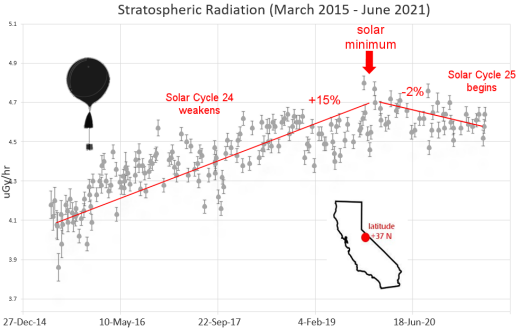
Cosmic ray dose rates peaked in late 2019, and have been slowly declining ever since. This makes perfect sense. Solar Minimum was in late 2019. During Solar Minimum the sun's magnetic field weakens, allowing more cosmic rays into the solar system. We expect dose rate to be highest at that time.
Now that Solar Minimum has passed, the sun is waking up again. Solar magnetic fields are strengthening, providing a stiffer barrier to cosmic rays trying to enter the solar system. The decline of cosmic radiation above California is a sign that new Solar Cycle 25 is gaining strength.
.Who cares? Cosmic rays are a surprisingly "down to Earth" form of space weather. They can seed clouds, trigger lightning, and penetrate commercial airplanes. According to a study from the Harvard T.H. Chan school of public health, crews of aircraft have higher rates of cancer than the general population. The researchers listed cosmic rays, irregular sleep habits, and chemical contaminants as leading risk factors. Somewhat more controversial studies (#1, #2, #3, #4) llink cosmic rays with cardiac arrhythmias and sudden cardiac death.
En route to the stratosphere, our sensors also pass through aviation altitudes:
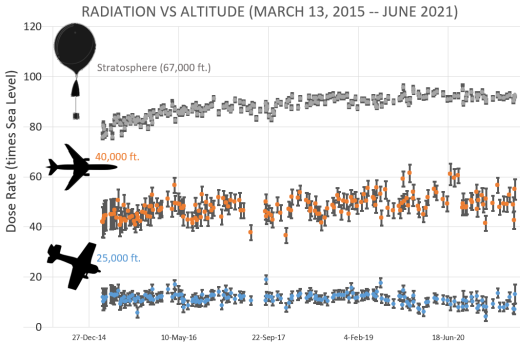
In this plot, dose rates are expessed as multiples of sea level. For instance, we see that boarding a plane that flies at 25,000 feet exposes passengers to dose rates ~10x higher than sea level. At 40,000 feet, the multiplier is closer to 50x. The higher you fly, the more radiation you will absorb.
Technical notes:
The radiation sensors onboard our helium balloons detect X-rays and gamma-rays in the energy range 10 keV to 20 MeV. These energies span the range of medical X-ray machines and airport security scanners.
Data points in the first graph ("Stratospheric Radiation") correspond to the peak of the Regener-Pfotzer maximum, which lies about 67,000 feet above central California. When cosmic rays crash into Earth's atmosphere, they produce a spray of secondary particles that is most intense at the entrance to the stratosphere. Physicists Eric Regener and Georg Pfotzer discovered the maximum using balloons in the 1930s and it is what we are measuring today.
| | The official U.S. government space weather bureau |
| | The first place to look for information about sundogs, pillars, rainbows and related phenomena. |
| | Researchers call it a "Hubble for the sun." SDO is the most advanced solar observatory ever. |
| | 3D views of the sun from NASA's Solar and Terrestrial Relations Observatory |
| | Realtime and archival images of the Sun from SOHO. |
| | information about sunspots based on the latest NOAA/USAF Active Region Summary |
| | from the NOAA Space Environment Center |
| | fun to read, but should be taken with a grain of salt! Forecasts looking ahead more than a few days are often wrong. |
| | from the NOAA Space Environment Center |
| | the underlying science of space weather |
 | Going above and beyond to provide the best homes listings in the Comox real estate market to keep you up to date and informed |
 | Looking for sports betting companies not registered on GamStop? CasinoGap has presented a list of sites not on GamStop available for UK players. Check and bet online! Would you like to bet at sites not using GamStop? Look at a list of NonStopCasino sites for online betting that aren't on GamStop. Top-rated bookmakers ever! |
 | One of the most popular casino games is the Book Of Dead Slot based on ancient Egyptian text, you can find all the casinos with spins at bookofdeadslotsites.com. |
 | When looking for casinos to play online when the weather is bad, you can try luotettavat nettikasinot for Finnish games. If you are not from Finland you can try the Swedish page Svenska casino online to find suitable games, check out svenskacasinoonline.net. Always check your local laws before playing with real money. |
 | Finns rank fourth among the world’s biggest gamblers. More on Finnish online casinos you can find at Nettikasino site. |
 | To find reviews of new online casino sites in the UK try The Casino DB where there are hundreds of online casino reviews complete with bonuses and ratings. Alternatively, Online-Casinos.xyz is another massive directory of online casinos listing sites for the UK and Worldwide. Casinos that offer Rupees for bonuses are very generous to Indian players. Find the best online casinos in India at AllCasinos.in Looking for a new online casino? Try Casimpo the new site dedicated to making online casino simple, or check out the new Avenger Slots Casino and Ace Online Casino with over 500 online slots and casino games. |
| | These links help Spaceweather.com stay online. Thank you to our supporters! |
| | | | | | |

